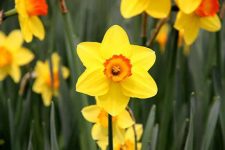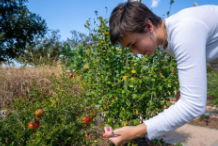Rhubarb is a perennial vegetable that can be a bit tricky to grow in Kansas. It is native to northern Asia (possibly Siberia) and so is adapted to cold winters and dry summers. However, it is susceptible to crown rot and should not be subjected to “wet feet.” It should be grown in a well-drained soil. The addition of organic matter can increase drainage as well as raise the soil level so that crown rot is less likely. Also, have a soil test done as rhubarb does best with a pH below 7.0.
Rhubarb should be planted from mid-March to early April in Kansas. Mix 5 to 10 pounds of well-rotted barnyard manure into the soil for each 10 square feet of bed before planting.
Rhubarb is propagated from crowns (root sections) that contain one or two buds. Plants should be spaced 2 to 3 feet apart in the row with 4 to 5 feet between rows. The crowns are planted shallow so that the buds are just one-half to 1 inch below the soil surface. Firm soil around the crowns and make sure they are not in a depression that holds water. You may want to ‘hill’ the plants slightly to prevent water from collecting around the crown which can lead to crown rot. Recommended varieties include Canada Red, Crimson Red, McDonald and Valentine.
Rhubarb needs rejuvenated at least every 5 to 10 years and should be dug and divided from mid-March to early April. Use a cleaver or ax to cut crowns into sections that each contain one or two buds. Plant as described above.
Newly transplanted rhubarb should not be harvested the first year so the plant can recover from the transplant process. Only a few stalks should be harvested the second year to allow the plant to continue to build up its energy reserves. The harvest season for plants that are three years or older usually lasts about 8 weeks. Harvest only the largest and best stalks by pulling them slightly to the side so that they break away from the plant. Never harvest over one-third of the leaf stalks at one time. Only the leaf stalk (petiole) is eaten as the leaf blade contains oxalic acid and is poisonous.
Established rhubarb should be fertilized in late March. Fertilize according to soil test or use a 10-10-10, 12-12-12 or similar fertilizer and broadcast or band at the rate of 1.5 to 2 pounds per 100 square feet or about 1/2 cup per plant.
An additional 1/4 cup of fertilizer per plant of a high nitrogen fertilizer such as a 27-3-3, 28-4-4 or something similar in late June or July after the last harvest is often helpful to stimulate recovery from the harvest season. Though most of these high nitrogen fertilizers are lawn fertilizers, each will work well for our purposes as long as they do not contain weed killers or weed preventers.
Mulches can be used to reduce moisture loss, prevent weed growth and provide winter protection. However, it should be pulled away in the spring to allow the soil to warm so that early growth is encouraged.
Ward Upham, Extension Agent




